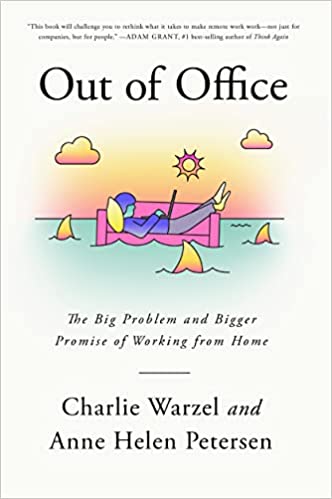You have /5 articles left.
Sign up for a free account or log in.
 Out of Office: The Big Problem and Bigger Promise of Working from Home by Charlie Warzel and Anne Helen Peterson
Out of Office: The Big Problem and Bigger Promise of Working from Home by Charlie Warzel and Anne Helen Peterson
Published in December 2021
As 2022 begins, the continued pandemic is pushing many of us in higher education to work as if we were in 2030.
We all knew that flexible, distributed and remote campus work was coming. We just didn’t expect that future to arrive so quickly.
And what have we learned from nearly two years of enforced remote higher education work?
Mostly, we learned that it sucks.
As the exquisitely well-timed new book Out of Office makes clear, the time has come for every employer (including universities) to rethink work.
Out of Office was not intended to be a book about working during a pandemic. The book’s authors, Charlie Warzel and Anne Helen Petersen, are partnered journalists who transitioned from N.Y.C. to remote Montana work a few years back.
The book that Warzel and Petersen set out to write was more a “best practices” for what we once called telecommuting. The book they ended up writing is much more interesting.
In examining when and how remote employment succeeds and fails, Warzel and Petersen discovered that the challenge is not with working remotely but our entire relationship with work.
In an age of employment insecurity, endemic understaffing and economic volatility, we’ve all become somewhat neurotic about our jobs. While only 40 percent of Americans work in the sort of symbolic analyst/knowledge worker roles that lend themselves to remote work, almost all of this group feels vulnerable and insecure.
Who doesn’t remember the layoffs that came with the recession and dot-com bust of the early 2000s? How fresh in our minds are the cuts and job losses of the Great Recession from 2007 to 2009?
Entire industries such as journalism have been decimated by the rise of the big tech platforms. Most companies—and universities—now follow a strategy of lean staffing, doing everything possible not to create permanent jobs with benefits.
As described in Out of Office, prior to the COVID pandemic, we were living through a pandemic of overwork. For too many of us, our work has become our identity. Laptops, phones, email and Slack allow us to work whenever and wherever.
COVID-19 may have pushed us to remote work. But the culture of working all the time predates the pandemic.
The big take-home message of Out of Office is that companies (and again, I’ll include universities) need to invest the time, resources and effort to redesign how work occurs.
Very few organizations (and universities) have a single person dedicated to leading the design of remote and flexible work.
Throughout the pandemic, most workers have had to figure out on their own how to make their work productive and sustainable. As we begin yet another semester of navigating the pandemic, the time has come to recognize that work (including higher ed work) will never be the same.
The good news is that flexible work arrangements are here to stay. Most people who work in higher education will not work from home full-time. But some of us will. And many of us in the most privileged of higher ed roles will work some days on campus and some from somewhere else.
The future of higher ed work will look like the future of higher education teaching and learning. It will be distributed, flexible and blended.
We need to think carefully about creating higher education employment conditions that will enable all of us who work in academia to enjoy a healthier relationship with our jobs. This means encouraging the setting of boundaries while simultaneously investing the entire academic labor force with trust, autonomy and security.
There is a good conversation to be had about the future of higher ed work. Reading and talking about Out of Office would be a productive strategy for energizing that discussion.
What are you reading?








